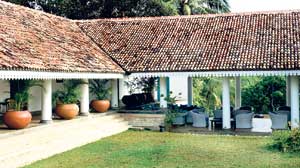
Tamarind takes root amidst old world charmTwo mongooses dashed across the little side lane which, unexpectedly, led to the luxurious new Tamarind Hotel, the fourth in a series of beautiful boutique hotels managed by Taru Villas. Comfortably snuggled in and well hidden from the main street, Tamarind Hill, or Thistle Court as it was once known, was the residence of a British Admiral based in Galle, and later a High Court Judge of the colonial era. The Dutch period architecture has been both preserved and expanded to give guests the ultimate boutique hotel experience.
After a warm welcome, a refreshing watermelon drink and a sumptuous lunch, we took a walk through this newly renewed piece of history. With the soft sounds of Norah Jones playing in the background it was easy to just relax and take a refreshing break from the hectic world outside. All the old world charm of the Dutch and colonial eras is present in the hotel. It is not hard to imagine all the colonial grandees who once made this mansion a part of their lives. In addition to the charm of the hotel it also offers all the modern conveniences that would be appreciated by any holidaymaker whose sole intention is to relax. Each room has a TV, DVD player, cable TV connection, stereo system and mini-bar. The two suites have a private bar equipped with everything from glasses to ice buckets. The largest in its series, Tamarind Hill comprises eleven rooms and two suites, and was opened on December 15 last year. It is part of the only boutique hotel chain that is managed solely by Sri Lankans.“It took around two years to complete everything, from renovation to decoration,” says Jacqui Fernando, Manager, Marketing and Sales at Taru Villas.
Anyone who takes a tour of the hotel could see this for themselves. From the main lobby to the bathrooms, every inch of space caters to the holiday maker’s every need. Each room displays stylish antique furniture and ornaments hand picked by designer/owner Nayantara Fonseka or Taru, as she is known. The character of Tamarind Hill lies also in some of the original décor. A large wooden panel, depicting newly painted Sri Lankan scenes, hangs over the main dining area. It is said to have served as a fan for the diners. In days of old, long ropes were attached to both sides of the bottom of the panel. These ropes would be pulled to and fro by servants, causing the panel to swing, fanning the people below. “When Tamarind Hill was first discovered by Taru, it was in a state of almost total disrepair,” says Jacqui, adding that nevertheless, Taru was able to see its potential, and kept whatever was restorable, including the solid wooden staircase and wooden panelling on the floors. The main building overlooks a typical courtyard with the big Tamarind tree that gives the Hotel its name. The extended section comprises eleven rooms, standard and deluxe. Rates range from US$ 170 a night to US$ 1005 per night. |
|
||||||
|| Front
Page | News | Editorial | Columns | Sports | Plus | Financial
Times | International | Mirror | TV
Times | Funday
Times || |
| |
Reproduction of articles permitted when used without any alterations to contents and the source. |
© Copyright
2008 | Wijeya
Newspapers Ltd.Colombo. Sri Lanka. All Rights Reserved. |

